After much build-up and hype, DC’s big Blackest Night event finally began this summer, and is roughly halfway over now. The Green Lanterns, as well as numerous other heroes, are put to the test by the appearance of Black Lanterns — fallen heroes revived to extinguish all light from the universe. One could call it a glorified zombie event, but is there more to it than that? Let’s look at all the material released thus far.
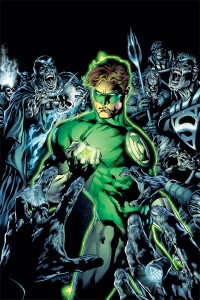
To clarify, this review will cover Blackest Night #0-4, Green Lantern #43-47, Green Lantern Corps #39-41, Blackest Night: Batman #1-3, Blackest Night: Superman #1-3, Blackest Night: Titans #1-3, and Blackest Night: Tales of the Corps #1-3.
Before the event officially began, Blackest Night #0 served as a preview, showcasing Barry Allen and Hal Jordan discussing the nature of death, and the recently deceased fellow Justice League members. It provides an interesting setup, along with a quick, but very straightforward example of what the Black Lanterns are all about. Green Lantern #43 also served as a prologue to the event by showcasing the back story and creation of the primary Black Lantern, the Black Hand. It is a rather morbid story, but I find it intriguing, and very informative.
Although the Tales of the Corps miniseries is considered part of the core event, it consists almost entirely of stories set in the past about different types of Lanterns. The Blue Lantern story, about Saint Walker, is the one I find the most enjoyable. It’s a story of hope and faith, as one might expect, but it also has a few neat plot twists. It has sort of an uplifting feeling, especially when combined with the soft, vivid art style. For the Sinestro Corps, there is a bizarre, yet entertaining story about Mongul’s childhood. The art is decent, but seems a bit lacking in detail at times. Then there is the Indigo Tribe story, which gives a glimpse into their nature and abilities for the first time. It’s not bad, but it feels far too brief, and I found it a tad confusing. The art does not disappoint, however, in that it has no particular flaws to speak of. For the Red Lanterns, we are given a tragic tale about Bleez. The writing is decent and somewhat thought-provoking, and the art is mostly well done, too. But for a story about someone who is supposed to be incredibly beautiful, it doesn’t show in most panels. The Star Sapphire story is about Carol Ferris, and its ending feels a bit dissatisfying and rushed. Its art features a distracting amount of purple, but is otherwise rather solid. Next is the Orange Lantern story, which is about Blume, and is definitely lacking in substance, but that’s probably the point. In contrast, the art is much more substantial, though. Finally, we’re given two Green Lantern stories. One about Kilowog’s rookie days, which I’d consider the second best story in this series. Its artwork is decent, but seems a bit simplistic in places. Second, there is a tale about Arisia and her family. The story is okay, but the artwork really stands out, with solid lines and sharp coloring. And, though the writing and inner art may be segmented and unrelated, the three covers actually form one large image featuring a significant member of each of the seven Lantern groups, with Hal Jordan fittingly in the “center” on #2. It’s drawn rather well, with every Lantern in a cool action pose (especially Hal, naturally), and vivid colors to accentuate each of them.
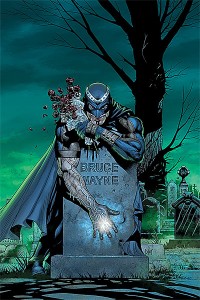
In the main, titular series, the story begins with a memorial day for fallen heroes, which ends on an ill note when a swarm of black rings revives nearly all of them as Black Lanterns. Additionally, they begin to kill living heroes, and resurrect them as Black Lanterns as well. Hal Jordan, Barry Allen, the Atom, and Mera make up a resistance, until the Indigo Tribe arrives to reveal the way to defeat the Black Lanterns. The Indigos leave Earth with Hal, leaving Barry and the others to spread the word and hold the fort as things go from bad to worse. The latest issue ends with a cliffhanger that I find quite intriguing, but the story up until then is definitely enjoyable as well. The dialogue can be a bit corny at times, but it’s often a really fun sort of corny. My only complaint is that the accessibility for a newcomer (like myself, for the most part) can be rather difficult at times. Sometimes it’s even a little hard to find a character’s name to potentially research their background and understand their connection. There are certainly attempts to explain things, but, considering the circumstances of the story, it’s nearly impossible to explain everything, so I was still left confused many times until I looked something up. I also find that the art can sometimes make it difficult to distinguish the Black Lanterns, since they’re all so similar visually. It’s not that the art is bad, because I do think it looks amazing. I believe the flaw is simply the fact that they’re all corpses who wear matching black uniforms. These comments about the art apply to issue #0 as well, since it was done by the same artist in the same style. The covers also have the distinction of being by the same artist, and thus have the same style and level of quality. #0 features a simple image of Hal backed by glimpses of numerous other Lanterns, and it looks fine, but there isn’t much else to say beyond that. The normal issues, on the other hand, each feature very dark, morbid images of Black Lanterns. #2 differs slightly by having Hal as a source of light in the middle of all the darkness, which is certainly one of the biggest themes of this entire event. But, overall, they look amazing, and my only complaint would be the lack of Barry on them, but it seems that will be fixed on future issues’ covers.
The portion of the story shown in the Green Lantern series is much less linear, at least at first. We are initially shown Barry and Hal fighting the resurrected Martian Manhunter, followed by John Stewart’s encounters with the Black Lanterns. Battles between the Sinestro Corps and the Star Sapphires, the Red and Green Lanterns, and the Blue and Orange Lanterns, are interrupted by the rise of their dead as Black Lanterns. Hal and the Indigos then arrive to form a reluctant alliance with Sinestro and Carol Ferris, and begin seeking out the other Lantern groups. Maybe it’s because of all the back story within the aforementioned Tales of the Corps miniseries, or maybe it’s due to the smaller amount of Black Lanterns with focus, but I find these issues much easier to follow than the core Blackest Night series. This is the opposite of what I’d logically expect, considering this is part of an on-going series, and the other is a somewhat standalone miniseries. I think I may also enjoy it a bit more, if only for that reason; it’s easier to become interested and invested in the characters and story if you don’t have to Google things. My only complaint is that John Stewart’s role seems forgettable and unimportant so far, making one question why he’s even included in the first place. But, in context, it seems certain that there will be more of him in future issues, so his role may grow after all. The art could also be a factor in the slightly increased enjoyment, because it features a bright, varied palette due to the seven Lantern colors featured, and frankly, rainbows are pretty. But the overall style is equally amazing, albeit different, and a tad less harsh. This also applies to Green Lantern #43, at least for the style; it has a very dark and black palette, due to being solely about Black Hand, after all. The covers, meanwhile, all have the same artist and style as the rest of the pages. #43 has a simple, but highly effective image of Black Hand. The other issues are also relatively simplistic in that they each feature action shots of two or three people with little to no background detail. I find that they all look great, but only #43 and #44′s covers are particularly outstanding.
The other on-going series, Green Lantern Corps, focuses on the defense of Oa by the likes of Guy Gardner, Kyle Rayner, Soranik Natu, Arisia, and Kilowog, among others, as black rings infect the remains of their fallen Green Lantern brethren. Like the Green Lantern series, I’ve also found these issues rather easy to jump into, for likely the same reasons as the Green Lantern issues. And, again, it feels very easy to get to know the characters and understand their relationships to those revived as Black Lanterns. But accessibility aside, I find this to be a good story to tell, and I definitely enjoy reading it. The artwork, meanwhile, is a lot quirkier than in most of the other series, at least for the living characters. But the action sequences and the designs of the Black Lanterns all have a rough feel to them, which creates an interesting good versus evil contrast. As with the last two series, the covers feature the same style and artist as the inner artwork. #39 and #41 are both simplistic, yet creepy, while #40 is more action-filled. I think they all look decent, and serve their purposes well.
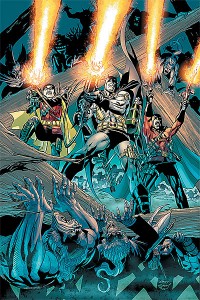
The Blackest Night: Batman miniseries features Batman and Robin, with some help from Red Robin, Deadman, and the Gordons, dealing with the desecration of Bruce Wayne’s grave, as well as the resurrection of other old friends and foes. It’s a decent story, and there’s a lot of really cool, fire-filled action sequences. But it felt slightly predictable, perhaps because dead relatives have always been an important theme in Batman comics. I also find the ending to be a bit dissatisfying, and slightly confusing. I had to read it through again to fully understand what happened, and it feels like it lacks closure. It’s somewhat understandable, since there’s still quite a bit of life left (pun not intended) in the overall event, but I just feel like something is missing. I have no complaints about the art, however. It looks great, it reflects the tone of the story well, and has no major flaws as far as I’ve noticed. For the cover art, the first and third issue have shots of Batman in pain, which look nice and sharp, and certainly fit the theme. But the second issue has a much different feel, with a smoother action shot, and frankly, I think it looks really cool.
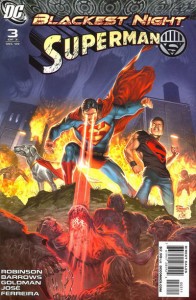
Another specialized miniseries is Blackest Night: Superman. In Smallville, the Kents have a reunion for their memorial day, which is rudely interrupted by Black Lanterns. Superman and Superboy face one Lantern, and Martha Kent and Krypto face another, until the town is faced with a third problem. Meanwhile, Supergirl and her mother have their own Black Lantern troubles on New Krypton. I find this a rather enjoyable read overall, but seeing Martha Kent, of all people, face a Black Lantern feels a little hokey. Especially considering the fact that she does at least as well as many superheroes thus far, though she does require Krypto’s help in the end. Meanwhile, the art is wonderful. The action and details are drawn and colored with obvious care. There are quite a few two-page spreads, and it’s hard to call it overkill, because they all just look great. Also, I can’t seem to pinpoint why, but Superman and Krypto in particular just seem to look really cool in every panel. And, although the covers are drawn by the same artist, they instead feature a solid, photo-realistic style, and each picture looks stunning for different reasons. Especially the third issue’s, which seems to just radiate a sense of, “These guys are really awesome.”
Finally, we have Blackest Night: Titans. In this miniseries, the group contemplates the deaths of their fallen members for the superhero memorial day, until they are suddenly reunited with them as Black Lanterns. The Titans struggle to fight them, and lose even more members, but they eventually discover that they have a secret weapon that can totally obliterate the black rings. Like the main Blackest Night series, I found this similarly hard to follow at times, but I suppose it’s obvious why. These issues also deal with a large team with a considerable amount of dead members. Some of the connections are obvious and explained well, but in other cases, I found myself overwhelmed and barely able to figure out who a Lantern was supposed to be. It’s just a lot to process for a newbie, and can perhaps only be fully appreciated by a veteran reader. Though, on that note, I found the writing to be decent overall, despite my personal confusion at times. The ending was particularly intriguing. Out of all the stories in this event so far, I would say that this one contains some of the blackest moments of all. I found said moments a bit cringe-worthy, but I don’t think they crossed any lines. Though, on that note, the art is another story, because there’s quite a bit of fan service. It’s a little awkward and distracting, but the art is otherwise okay, and features a slightly rough tone that I think looks pretty good. The cover art is done in the same style by the same artist, so it also has the same fan service tendencies. Thus, my feelings on it are the same as that of the inner art, but I will say that I really like the subject choices for each cover, because they all do a splendid job of conveying the dark, icky factors of the arc.
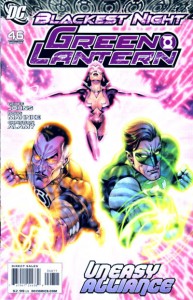
So, what are my overall feelings on the event thus far? A few nitpicks aside, I have no outstanding problems with the art or the covers. Everything has generally been eye-pleasing. But the writing is a tad more complex of an issue to narrow down. The Superman and Batman stories were fun, and all the Green Lantern books have been great. But the core Blackest Night series, unofficially starring the Justice League, and the Titans miniseries, are not very newbie-friendly, though I still enjoyed them anyway. Of course, as you may have noticed from my brief plot descriptions, there’s been a very repetitive formula throughout all the different aspects of the story. I still enjoyed things in spite of that, but it does kind of hurt Blackest Night’s originality points. However, the main story has just hit a point where the heroes have discovered multiple ways of combating the Black Lanterns, while at the same time, the Black Lanterns also now have a new ace up their sleeve. So, I definitely do think there’s some more life to the event (pun not intended), at least in the two main series; I honestly can’t imagine how other character-based arcs could possibly bring anything new to the table. My only other complaint would be about the fact that, despite his implied importance, Black Hand’s presence and activity has been scarce, so I kind of hope that he is used more later.
Cover Art: A (Pretty much all of them look really nice.)
Writing: B+ (Generally enjoyable, but there are a few weak points in some areas that are hard to ignore.)
Art: A (Not necessarily perfect, but everything looks great overall.)
Overall: A- (The artists have done well, and despite some writing flaws, they’ve definitely piqued my interest in the second half of the event.)
Green Lantern, and all related characters – © 2009 DC Comics. All Rights Reserved.







